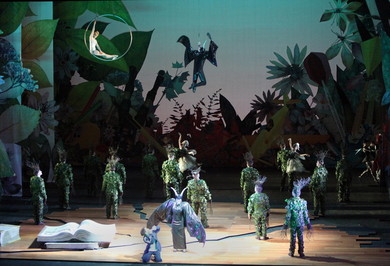New Stage
Premiere of this production: 19 Jan 2013
L'enfant et les sortileges: Fantaisie lyrique en deux parties (The Child and the Spells: A Lyric Fantasy in Two Parts) is an opera in one act, with music by Maurice Ravel to a libretto by Colette. It is Ravel's second opera, his first being L'heure espagnole. Written from 1917 to 1925, L'enfant et les sortilиges was first performed in Monte Carlo in 1925 under the baton of Victor de Sabata. After being offered the opportunity to write a musical work, Colette wrote the text in eight days. Several composers were proposed to Colette to write the music, but she only was enthused with the prospect of Ravel. Composition history During World War I, the Opera de Paris director Jacques Rouche asked Colette to provide the text for a fairy ballet. Colette originally wrote the story under the title Divertissements pour ma fille. After Colette chose Ravel to set the text to music, a copy was sent to him in 1916 while he was still serving in the war; however, the mailed script was lost. In 1917, Ravel finally received a copy and agreed to complete the score, humorously replying to Collette, "I would like to compose this, but I have no daughter." Ravel began composing the work in the spring of 1920, but then stopped due to physical exhaustion and poor health. He was finally compelled to complete the work by Raoul Gunsbourg, director of the Monte Carlo Opera, who insisted Ravel write a sequel to L'Heure espagnole. This was completed in 1924. Colette, who had believed that the work would never be complete, expressed her extreme pleasure, believing that her modest writing had been raised beyond its initial scope. Now officially under the title of L'enfant et les sortilиges, the first performance took place March 21, 1925 in Monte Carlo as conducted by Victor de Sabata with ballet sequences choreographed by George Balanchine. Ravel said of the premiere production: "Our work requires an extraordinary production: the roles are numerous, and the phantasmagoria is constant. Following the principles of American operetta, dancing is continually and intimately intermingled with the action. Now the Monte Carlo Opera possesses a wonderful troupe of Russian dancers, marvelously directed by a prodigious ballet master, M. Balanchine. ... And let's not forget an essential element, the orchestra."
The opera calls for a large orchestra, a mixed chorus of adults, a chorus of children and eight soloists, most of whom individually play a number of characters. The scale of the cast and fantastic setting make the opera often difficult to stage, which helps to explain why the work is not performed often. Ravel uses various subtle leitmotifs throughout the work, and there is considerable virtuosity in the instrumental writing. Yet the orchestra plays mostly secondary role to the sung melodies, Ravel explaining that he was following the style of Gershwin and American operettas of the time. Ravel contrasted the work to his previous opera, L'heure espagnole:
The opera was initially well received in Monte Carlo, but in a Paris production the following year it was less successful. Andre Messager criticized the purposely imitative nature of the music, but Francis Poulenc and Les six were impressed. His cat duet Duo miaule is often seen as a parody of Wagner which was quite controversial, although Arthur Honegger praised this piece in particular. The use of pentatonic music and parallel fourths in the depiction of the Chinese tea cup is an example of use of "orientalism" in orchestral music.
Synopsis Place: An old-fashioned Normandy country home Part 1 This is the story of a rude child who is reprimanded by the objects in his room which he has been destroying. After being scolded by his mother in the beginning of the opera, the child throws a tantrum destroying the room around him. He is then surprised to find that the unhappy objects in his room come to life. The furniture and decorations begin to talk; even his homework takes shape as it becomes an old man and a chorus of numbers. Part 2 The bedroom becomes a garden filled with singing animals and plants which have been tortured by the child as well. The child attempts to make friends with the animals and plants, but they shun him because of the injuries he did to them earlier before they could talk. They leave him aside, and in his loneliness, he eventually cries out "Maman". At this, the animals turn on him and attack him, but the animals wind up jostling among each other as the child is tossed aside. At the culmination, a squirrel is hurt, which causes the other animals to stop fighting. The child bandages the squirrel, then collapses exhausted. The animals have a change of heart toward the child, and decide to try to help him home. They carry the child back to his house, and sing in praise of the child. The opera ends with the child singing "Maman", as he greets his mother, in the very last measure of the score. © Bolshoi Theatre | ||||||||||


